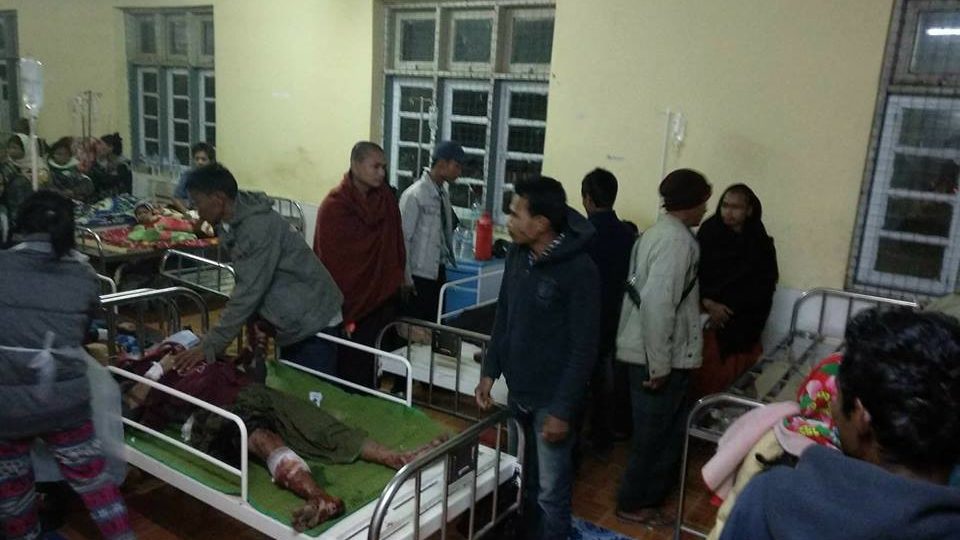Rakhine State police have confirmed that they opened fire on a crowd of protesters late last night in the ancient city of Mrauk-U in northern Rakhine State. At least seven people were killed and 12 were severely wounded by gunfire.
The protest erupted on Tuesday over authorities’ decision to cancel a celebration of the 233rd anniversary of the Mrauk-U Kingdom, which was conquered by the Burmese in 1785.
The celebration has been held each year on Jan. 15 and 16 since 2014. It normally features traditional wrestling matches and lectures by activists and politicians.
Some reports say the protesters were also upset about the arrest earlier that day of Rakhine nationalist writer Wai Hun Aung, who had given a speech encouraging Rakhines to take advantage of Myanmar’s political instability and seek independence. Wai Hun Aung was detained under Section 505(b) of the Penal Code, which prohibits public incitement. He was later charged under Section 17(1) of the Unlawful Associations Law for promoting the separatist Arakan Army.
Hundreds of people are gathering on the streets in Mrauk-U. They’re angry on the recent arrest of #Rakhine nationalist writer Wai Hun Aung who talked to public and allegedly criticised govt. Rumors spread that Dr Aye Maung is on the run.
— Mratt K Thu (@mrattkthu) January 16, 2018
Tun Thar Sein, a lawmaker representing Mrauk-U in the Rakhine State parliament, said he tried to explain to the crowd why the event had to be cancelled, by the protesters would not be calmed. Many of the protesters were local high school students.
Around 9:30pm, thousands of protesters marched to the Mrauk-U police station and then the district administration office, where they were confronted by police. Police said they started firing warning shots and rubber bullets after the protesters began throwing stones and destroying police trucks. Police officers fired real bullets when the protesters did not desist.
#HappeningNow. More than a thousand people are protesting by the lead of a nationalist monk in Mrauk-U.
— Mratt K Thu (@mrattkthu) January 16, 2018
“We went to the police station first to ask why is it exactly that the event has been canceled. They shifted the blame to the district administration, so we went there. While going there, our numbers grew bigger and bigger, so we protested. Initially, [the police] shot warning shots into the air but it didn’t take long for them to start shooting straight at us,” protester Aung Zaw Moe told Eleven.
Several gunfire to disperse huge crowded people in Mrauk-U. #HappeningNow
— Mratt K Thu (@mrattkthu) January 16, 2018
One man got shot by gunfire and on the way to the hospital, in Mrauk-U, #Rakhine, #HappeningNow
— Mratt K Thu (@mrattkthu) January 16, 2018
Police reportedly fired around 20 rounds in total by the time the protesters dispersed early Wednesday morning. The death toll gradually rose to at least seven in the following hours.
“The two dead bodies [I saw] had to be left where they died. We’ve asked whether we can get an ambulance to pick them up, but they declined. The bodies were sent to the hospital later,” Aung Zaw Moe said. The bodies were eventually taken to the hospital.
“I saw a boy’s abdomen hollowed out,” a high school teacher who witnessed the confrontation told the The Irrawaddy.
MP Tun Thar Sein followed the injured protesters to the Mrauk-U hospital. He told The Irrawaddy that some of them had been shot twice or more in the legs or abdomen. Some of the victims have been transferred to Sittwe, the Rakhine State capital, nearly 90 miles from Mrauk-U.
Injured people keep coming to the hospital after gunshots, in Mrauk-U, #Rakhine, #HappeningNow
— Mratt K Thu (@mrattkthu) January 16, 2018
No police have been reported injured.
“This mass killing would not have happened if they had used rubber bullets to crack down on the gathering,” the MP said. “I think the protestors only gathered bricks and stones and did not have any other weapons.”
The primarily Buddhist town of Mrauk-U has remained unscathed by insurgencies and military crackdowns that have brought destruction and mass displacement to neighboring districts with large Rohingya populations.
However, poverty and feelings of marginalization by the Bamar-dominated government of Myanmar are widespread among Buddhist Rakhines, which some observers say may have contributed to the protest’s descent into violence.




